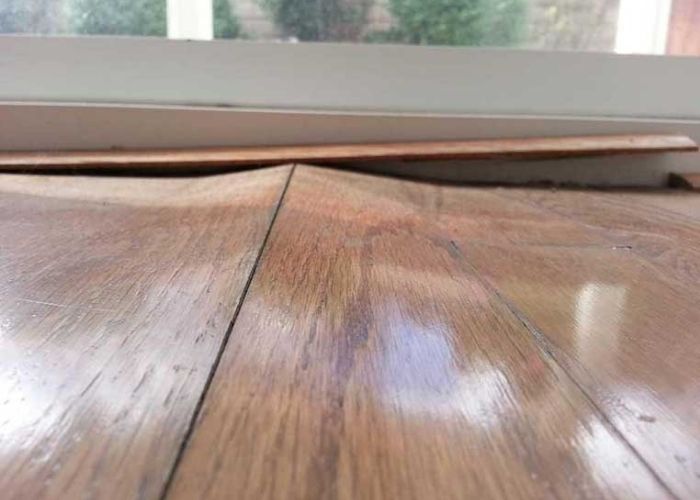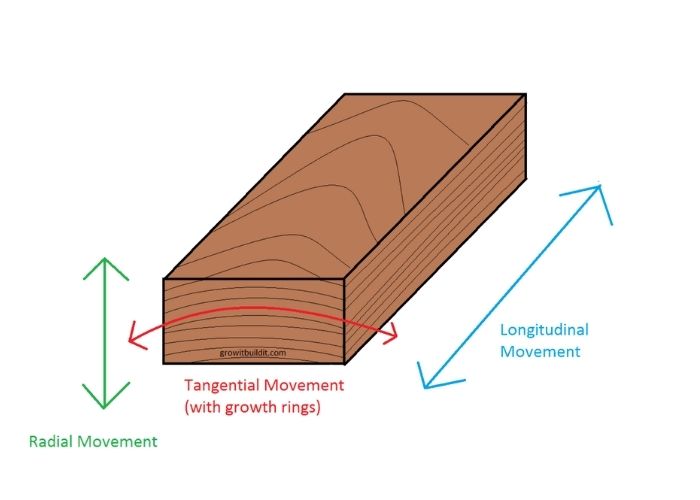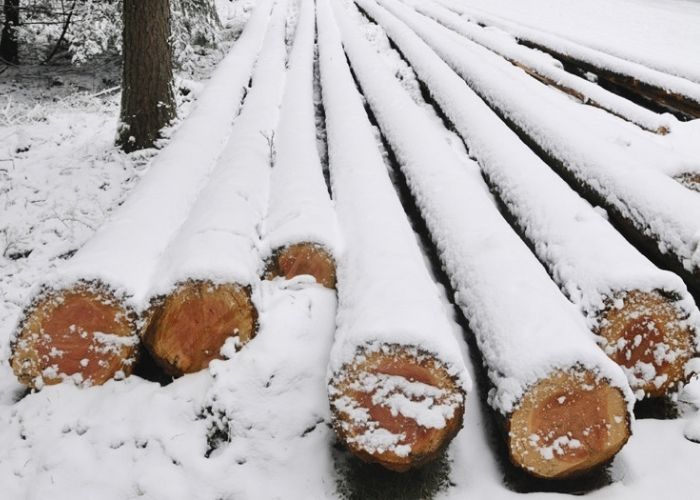It’s a cold winter day, and you’re huddled up inside trying to stay warm. But have you ever wondered what happens to wood when it gets cold outside? Does wood expand in cold or heat? Or maybe even change color?
As you already probably know, wood is also referred to as hygroscopic, meaning it changes with environmental changes. That said, hot, cold, or moist air in the surroundings will influence wood movement, directly or indirectly.
Read on to find out the answer to this burning question! (Pun intended)
Does Wood Expand In Cold?
No, wood doesn’t expand in the cold; it shrinks. Cold temperatures trigger the wood to lose some of its moisture to match the moisture content in the atmosphere, resulting in shrinkage. High air humidity is responsible for how wood behaves and not temperature variation.
Wood Expansion And Contraction: How Temperature Affects Wood
The real question here is if temperature shift impacts wood movement. If it does, then how does it work? Let’s find out.
How Does Humidity Affect Wood?

Moisture is the primary reason why wood expands and contract. Let me explain: Wood is a hygroscopic material because it constantly changes to match the external atmosphere changes.
Wood is a porous material and will always try to match its internal humidity levels with external humidity levels, a state called the Equilibrium moisture content (EMC).
As a result, the wood fibers swell as it absorbs moisture and shrink as it releases it –wood expansion and contraction.
If its internal humidity level is lower than that in the surrounding, the wood fibers will absorb moisture and expand when it reaches their saturation point.
But with low air humidity in the surrounding, the wood loses moisture and shrinks. However, note that wood moves with changes in the relative humidity, not just with any alterations in humidity levels.
By relative humidity, I’m referring to the ratio of absolute humidity (actual moisture content in the air) to the maximum moisture content at a specific temperature.
Warmer air temperatures will hold more moisture, explaining why absolute humidity can change while the relative humidity remains constant.
Conversely, should air temperature rise along with absolute humidity, relative humidity remains the same and, therefore, no movement in the wood.
Does Warm Temperature Affect Wood?
Yes, warm temperatures affect wood, though indirectly. Warmer temperatures will adjust the humidity levels in the atmosphere.
Warm air holds more moisture, so most shrunken wood cells reabsorb moisture from the atmosphere and expand.
Wood can expand and contract in moist warm temperatures. It all depends on the amount of moisture in the wood and the surrounding humidity levels.
How Does Cold Temperature Affect Wood?
Wood can expand or contract during cold months. This is because cold air carries little moisture, and so the wood would lose a little bit of its moisture to match the surrounding moisture level.
But if it is cold and wet, the wood cells will gain moisture from their surroundings and expand when it reaches saturation.
If you expose wood to extreme cold and freezing temperatures, the water or moisture in the wood will freeze and potentially push wood fibers apart, resulting in swelling or warping.
Again, the humidity levels in the wood and the atmosphere influence wood movement, not the temperature.
How Cold Weather Affect Wood Furniture
Cold weather affects wood furniture in the same way it affects other wooden surfaces. Cold temperature changes the humidity levels in the environment, triggering wooden furniture to shrink or expand slightly.
However, wood typically stays the same size, and the effects of expansion and contraction are barely noticeable. That’s because most wooden furniture is built in a way that allows for such movement.
As long as the wooden furniture doesn’t get wet, you can store it in a cold place, and it will remain in good shape for years.
How Wooden Doors And Floors Expand And Shrink In Winter

As we’ve mentioned before, wood can expand and shrink during cold months like winter. In this instance, here’s how dry winter weather can affect your wood floors and doors.
Humidity levels are usually lower during winter because cooler air carries less moisture. However, since the wood strives to achieve EMC, the doors and floors will shrink when its internal moisture content falls below saturation.
Yet, the hardwood flooring and doors can expand if they come into contact with the snow or wetness -this introduces moisture into the surrounding.
The wooden surfaces with potentially low internal moisture levels will absorb the external moisture and expand. Here’s another illustration; you hang your wet coat on a wooden door and leave it to dry.
And then you decide to warm yourself by the fireplace or using a heater. Again, the coat will begin to dry and, in the process, raise the humidity levels in the house.
The wooden door absorbs moisture; moisture expands it and makes it too tight for its frame. Soon it may start to crack, so ensure you know how to repair door frames with wood filler.
Wood Expansion:
How to Make Wood Expand
- Place the wood in direct contact with liquid water to force it to absorb water and eventually expand.
- Raise the humidity levels of the air surrounding the wood. A humid atmosphere will cause the wood cells to absorb moisture and expand.
- Heat wet wood so that it expands under normal thermal expansion. Cooldown the wood-heated using heat sources such as underfloor heaters. Once it cools down, it can expand.
How long does it take wood to expand?
The speed at which wood contracts and expands primarily depend on the wood’s porosity. Still, the wood could never expand beyond 50 % moisture content.
Hardwoods, like Oak or walnut, are very dense, and it takes longer for the moisture to penetrate and get absorbed into the wood fibers. As a result, dense wood expands very slowly.
However, softwoods like pine or Douglas fir wood are very porous. Moisture penetrates the pores pretty fast as it gets absorbed. That goes to say that softwoods expand faster than hardwoods.
Estimating wood expansion
By now, you know that wood moves, so you should allow room for movement during the construction stage.
Follow a rule thumb when estimating wood expansion. For example, allow for 1/4 inch total wood movement for every 12 inches for a board cut across the grain or radially to the growth rings. And allow for 1/8 inch movement space for quarter-sawn boards.
The length of the wood remains unaffected by expansion and contraction.
Direction of wood movement

All types of wood contract and expand following a predictable pattern. When you know the direction of the movement pattern, you can estimate the degree of movement and leave room to accommodate the change.
You can always expect wood to move longitudinally or in the radial and tangential directions of the growth rings.
Wood moves slightly when parallel to the grain (longitudinally). It shrinks about halfway across the growth rings –from the tree’s heart to the outer edge (radially). However, the major movement goes across the wood grain or the growth rings (tangentially).
Quarter-sawn board is considered more stable than plain-sawn boards. That’s because quarter-sawn timber is cut radially while plain-sawn lumber is cut tangentially.
How to Deal with Wood Expansion and Shrinkage
Wood expansion and shrinkage are natural, and no one can control or stop. But, you can do a few things to help reduce the effects of these natural changes on any wooden pieces in our surroundings.
- Seal the wood airtight with layers of epoxy resin. Apply as many layers of polyurethane resin to the wood until it is airtight. Once the wood can’t absorb external moisture, it can’t expand as much. Sealing wooden surface reduces the expansion of wood, but it doesn’t stop wood movement.
- Consider using plywood while constructing wooden furniture, doors, and other pieces, in place of solid timber. Plywood is made of cross-grained veneers and doesn’t have room to adjust to its changing environment as solid wood does.
- Only use the right type of high-quality hardwood to make furniture and other wooden pieces. High-quality wood-like hardwood is pretty stable. In addition, these woods are often dense, so absorbing and losing moisture is a very slow process, resulting in little to no change due to the weather conditions.
- An alternative way to deal with expansion and contraction involves disassembling “precious” furniture. You would have to disassemble while seasons shift from, say, summer to winter. This move will guarantee the furniture remains intact. Also, store them in a temperature and moisture-controlled space.
- Always leave new wood to acclimate to the new environment it will be located before you begin constructing structures. This helps the wood blend in and become familiar with the surrounding weather conditions.
- Avoid leaving your exterior furniture outside for prolonged periods. It also helps to seal them and prevent premature damage. Please read our article for options and recommendations for the best wood sealer for outdoor furniture.
FAQs
Does wood expand in heat?
Yes. When you subject wood to heat, it will expand due to normal thermal expansion. The thermal expansion could lead to swelling, warping, and potentially shrinkage. However, it will eventually contract when it cools down.
Does wood shrink in cold?
Yes, wood shrinks in the cold because of a drop in atmospheric humidity levels. The difference in moisture levels will cause wood to disperse its moisture and achieve equilibrium moisture content.
Does wood expand in winter or summer?
Wood tends to shrink in winter and expand during summer. This is because warm air in summer carries more moisture, and the wood absorbs it and expands. However, cold air doesn’t carry as much moisture, and wood would shrink or stay the same size. Therefore, wood will only expand during winter if it’s directly exposed to wetness.
Does wood expand?
Yes, wood expands up to its maximum during moist summer air, not the warm temperatures. Wood also expands whenever the atmosphere surrounding the wood is highly humid. Generally, wood will expand and contract half the space allowed for movement during the spring and fall seasons.
Does wood expand in heat or cold?
Wood expands in heat and contracts in the cold. However, changes in moisture levels determine the extent of wood movement and its direction.
Does sealing wood prevent expansion?
Not really, but sealing both ends of a wooden plank slows down the rate of expansion and contraction. In turn, it keeps the wood from warping sooner. However, sealing wood is a preventative measure, not a permanent solution to stopping wood from moving.
Does MDF expand and contract?
Yes, MDF will expand and contract in highly humid environments or exposure to damp surfaces. MDF boards move as a unit and expand up to 25 % its size. Ensure you allow room for such movement during the construction stage.
Does plywood expand and contract?
No, it doesn’t. Plywood is pretty stable and doesn’t expand and contract like solid wood. Plywood is made of cross-grained veneers glued and pressed together for tensile strength. Regardless of humidity levels and temperature, plywood remains unchanged.
What Next?
Does wood expand in cold or heat? It expands during heat and shrinks in the cold. However, a fluctuation in the relative humidity determines the extent of expansion and contraction, regardless of the temperature.
As a hygroscopic material, wood will always strive to achieve equilibrium moisture content between itself and its surroundings.
Therefore, it is possible to slow down wood movement, but you can’t completely stop it, especially if you’re using solid wood or MDF.
Interesting right? Here’s what to read next: How to bend wood with water.

